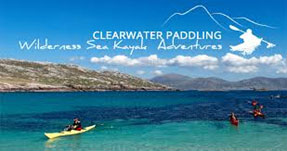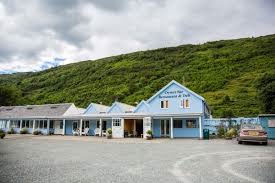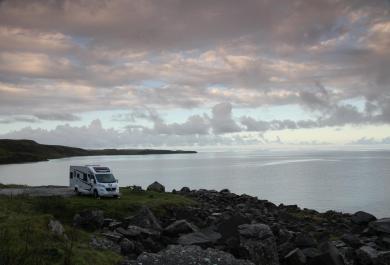
Outer Hebrides Motorhome Route
Your Guide to Camping in the Outer Hebrides
A motorhome holiday allows you the freedom to travel and move around without being timetabled to be in a certain location at a certain time.
The Scottish West Coast is one of the most beautiful places to explore on your motorhome holiday and when you combine it with camping in the Outer Hebrides, you are without a doubt in for a truly wonderful holiday. Picture a paradise of powder-white beaches and the clear blue water of the Atlantic waves, dark moorland and rugged mountains, amazing wildlife and rich and vibrant culture.
This route combines some of our Scottish west coast route with the Outer Hebrides route. We will also give you some suggestions of where you can park your campervan hire as well as places that you can visit. We enjoy the freedom of wild camping but have suggested some campsites to stay at along the way.

Day 1 of Motorhome Camping in the Outer Hebrides
Starting in Perth at Scottish Tourer’s base, take the A9 North towards Inverness. Depending on how long you want to drive, about 45 minutes from Perth is the Blair Atholl Campsite, which is great for an overnight stop. If you don’t want to go far, you could visit Blair Atholl Castle or if you are happy to continue north then head for Aviemore which is a 2.5-hour drive from Perth.
House of Bruar
On the way to Aviemore, we would recommend stopping at the House of Bruar. This stop has a fantastic food hall, selling some of the finest meats at the butcher counter and cheeses in the delicatessen.

We think it’s a must-visit to pick up a few treats for your holiday. There is also the opportunity to browse in the clothing and homeware stores. They have a huge range of branded clothing for any gifts or something special for yourself.
The Highland Folk Museum (Turn off at Kingussie)
The Highland Folk Museum is a fantastic stop and gives visitors a flavour of how Highland people lived and worked from the 1700s up until the 1950s. This is done by displaying over 30 historical buildings and furnishing them appropriate to their time period. Some have been built from scratch on-site and some have been moved here from other locations.
.jpg)
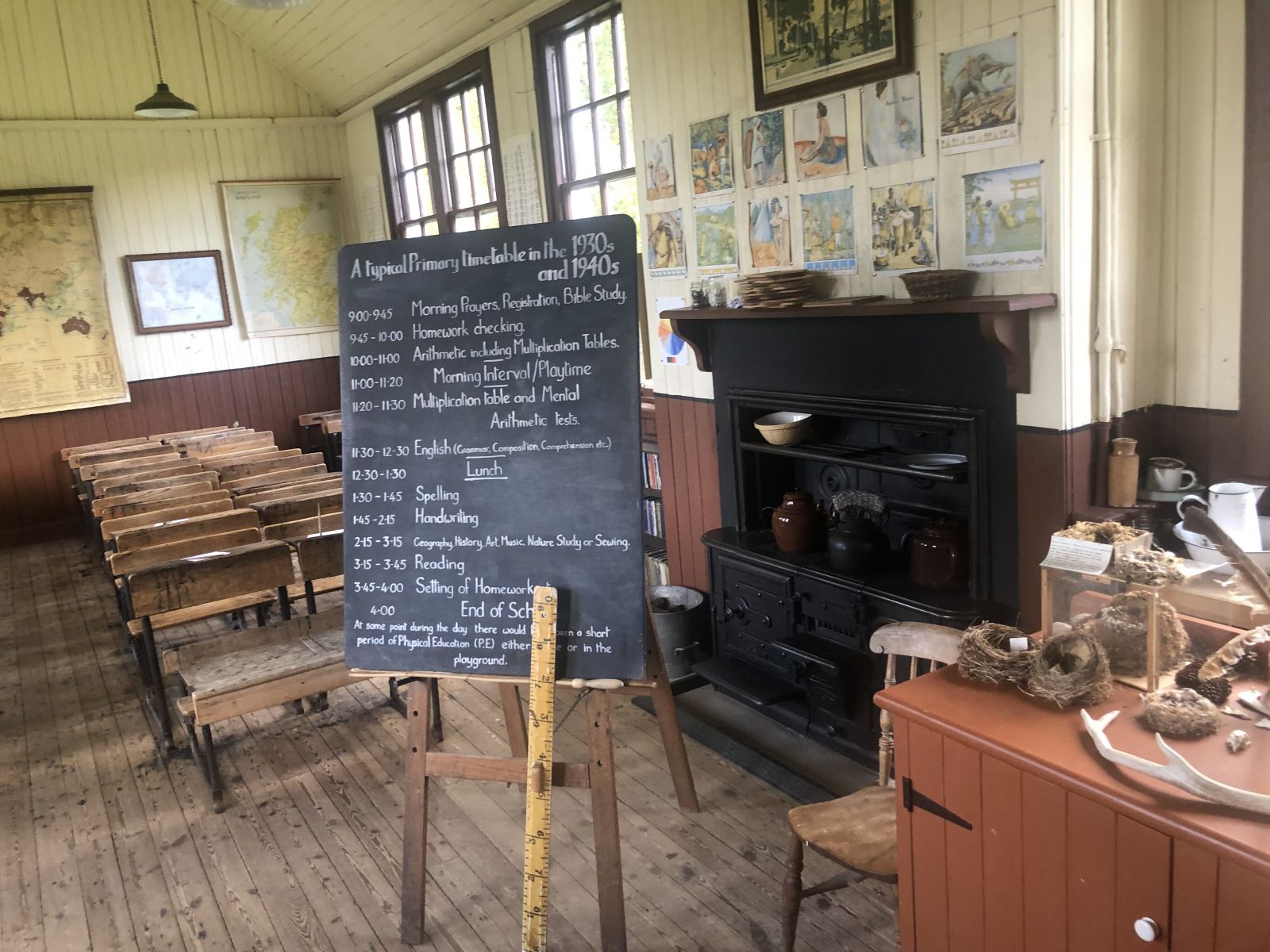
Highland Folk Museum at Kingussie
The site is a mile long with 1700s Township (featuring six houses) at one end through to our 1930s working croft at the other, located at Newtonmore in the Scottish Highlands amidst some of the most beautiful scenery in the world.
Camping Sites Outer Hebrides
Glenmore campsite is only a short walk from Loch Morlich beach, but the campsite itself is with the Glenmore Forest park and has all the facilities you will need. A campsite can be a good base for your first night and allow you to get to know the motorhome.
Wild camping is also available at the Ski Centre – just don’t forget to put your £5 in the honesty box! In the morning, you could enjoy a trip on the funicular railway. The 2 km journey up the hill is the highest railway in the UK.
Day 2 of Motorhome Holiday Route
If you have children with you, we highly recommend visiting Landmark before you make the journey to Ullapool. The children will love exploring the nature reserve and playpark!
Landmark Forest Park
Landmark Forest Adventure Park is just outside of Aviemore at Carrbridge. You can easily spend the whole day here exploring. You can explore the recently opened Dinosaur land, go hunting for red squirrels on the ancient pine, or dive into the adrenaline-filled water slides. This is a great day out and there will be something for everyone.
Strathspey Steam Railway
In Aviemore itself, the Strathspey Steam Railway has been running for 42 years now. The steam train and the line were reinstated by a team of volunteers who have worked to keep the train in fantastic condition. This nostalgic train is a must to enjoy the beauty of the Scottish highland while you sit back relax and enjoy a cream tea.

When you have finished exploring Aviemore, continue to head north towards Inverness and take the A835 towards Ullapool.
Campsite
Broomfield Campsite is near the ferry port and in a fantastic location to watch the ferries and fishing boats come and go. Within walking distance of the town, you can enjoy a meal out in one of the many restaurants – the seafood shack is highly recommended.
Broomfield campsite
Day 3 of Motorhome Camping in the Outer Hebrides
Today, we will be leaving the west coast of Scotland and catching the ferry at Ullapool to take go to Stornoway. The ferry to Stornoway (Isle of Lewis) takes just over two and a half hours. While onboard, you can savour a cup of tea in the restaurant and enjoy the crossing.
Upon arrival on the Isle of Lewis, take the A857 East then turn right onto the A858. Turn right again after a few miles to visit the Blackhouse Museum.
The Blackhouse Museum
The Blackhouse Museum is run by Historic Scotland. You can walk around here to see how Islanders lived in the houses where they lived alongside their animals and without chimneys.

The Blackhouse Museum
The Blackhouse here at Arnol was probably built as recently as 1875. It’s fully furnished as it would have been when it was inhabited but the design of black houses dates back hundreds of years.
The Whalebone Arch
The Whalebone Arch, in Bragar, is one of the landmarks you will see as you travel around the northern tip of Lewis. It was erected by the former village postmaster Murdo Morrison, was formed from the jawbones of a giant whale which beached itself and died in Bragar Bay after been harpooned by hunters.

Whalebone Arch
The whalebone arch has become a bit of a tourist attraction, standing at 25 feet and weighing 4 tons. It has been coated in fibreglass to preserve and protect it. You can see the Harpoon hanging in the centre of the arch.
Head South on the A857 to the Village of Callanish and you’ll arrive at the Callanish Stones.
Callanish Stones
Construction of Callanish Stones is thought to have taken place between 2900 and 2600 BC. But it is possible though that some buildings were here before 3000 BC. There was a tomb built into the site at a later date, investigating some of the debris. From the destruction of the tomb, it suggests that this site was not used between 200 BC and 1700 BC.
The Callanish Stones
There are 13 primary stones which form a circle. 13 metres in diameter, there is an avenue of stones on the north approach and shorter stone rows to the south, east, and west approaches. The layout resembles a Celtic cross and the stones vary from one metre to five metres in height. The Visitor centre gives a fascinating insight to the area.
Our last recommended visit for the Isle of Lewis today is the Iron Age Village, a fabulous overnight spot at Uig.
The Iron Age Village
The Iron Age of Great Bernera was first discovered at Bosta in 1993 after a huge storm and gales revealed the remains. Long excavations followed which revealed some very important and interesting finds. Using the new information, archaeologists built a reconstruction of an entire iron age house of the time, which is part of the exhibition and is open to visitors.

The Iron Age Village
Overnight Parking
Ardoil Campsite Isle of Lewis is located just outside of Uig. You will find a basic but fantastic community-run site which relies on donations from their customers. There is a tap to top up the fresh water, chemical waste point, toilet/shower block. You can also park on the edge of the beach in this stunning location.
Kneep at Traigh na Beirigh is a lovely campsite ideal for motorhome parking on the Isle of Lewis. Nestled in the sand dunes with white sandy beaches, this campsite is an ideal base for overnight.
Wild camp spot by Uig
Wild camping on the Isle of Lewis is also an option and the Outer Hebrides welcome responsible motor homers. See below the photo of us parked up on the white sandy beach by Uig. We have many places where wild camping around Outer Hebrides is available, and this can be found in the pre-programmed sat nav which comes with your motorhome.
Day 4 of Motorhome Hire Holiday
Today, we continue our Outer Hebrides adventure round the west coast of the Isle of Lewis by heading south towards the Isle of Harris. But before we leave the Isle of Lewis, we recommend another few stops.
Seatrek
Seatrek is based in Uig which we think is one of the most beautiful places in the UK. They offer boat trips around the Hebrides and land on uninhabited Islands with the opportunity to see whales, dolphins, basking sharks, sea eagles, and puffins.

Sea trek boat trip
Abhainn Dearg Distillery
Abhainn Dearg Distillery (pronounced Aveen Jarræk) is located in Uig on The Isle of Lewis. The distillery was founded by Mark Tayburn (Marko) and is the first legal whisky distillery in the Outer Hebrides in almost two hundred years.

Abhainn Dearg Distillery
The distillery was established in 2008, and the first spirit to leave the island was in 2010 when two small casks of new spirit were sold. The distillery offers its guests a guided tour around the distillery and the opportunity to have a wee dram at the end of the tour. You can also treat yourself to something from the distillery shop.
Lewis Chessmen
The Lewis Chessmen were found in the vicinity of Uig on the Isle of Lewis in mysterious circumstances. Various stories have evolved to explain why they were concealed there, and how they were discovered.
All that is certain is that they were found sometime before 11 April 1831, when they were exhibited in Edinburgh at the Society of Antiquaries for Scotland. The precise findspot seems to have been a sand dune where they may have been placed in a small, drystone chamber.
The Isle of Lewis Chessmen
The chessmen were probably made in Norway, in the 12th century, during that period, the Outer Hebrides, along with other major groups of Scottish Island, were ruled by Norway. The chessmen were discovered in early 1831 in a sandbank at the head of Camas sandbank on the west coast.

The map above takes in our suggested route taking in Uig.
Leaving the Isle of Lewis, we head South on the A859 to Harris, following the coast road. On arrival at the Harris, you will probably be ready to look for somewhere to stay overnight. Luckily, motorhome parking is available in campsites or wild camp spots.
Campsites Isle of Harris
Tallanmara Campsite is a more conventional campsite, with available electric hook ups, shower facilities, chemical toilet disposal, water, and recycling centre.
Seilebost School is only a few pitches available within what was the old primary school ground, but it has access to a toilet block and electric hook up and only a short walk to the beach.
Community spot also offers the opportunity to stay overnight in designated spots where a fee of £5 is asked as a donation. The money raised is used to maintain the camp spots but also help with community projects.These spots are marked with a small sign to identify the area and offer fantastic views and located in Luskentyre and Seilebost.
Parking in the Isle of Harris
Wild camping parking on the Isle of Harris is, in our opinion, stunning and we have discovered many wonderful parking spots on the Isle of Harris. We consider Harris to have some of the best beaches in the world. You can even drive the motorhome right down to some of the beaches and stay overnight. Get the barbeque table and chairs out of the garage, sit down relax and enjoy a glass of your favourite tipple in a remote area in peace and quiet, which is what a motorhome holiday is all about.
Day 5 of Motorhome Camping in the Outer Hebrides
Before leaving Harris to head for the ferry to North Uist, there are a few things we think may be of interest to you.
Harris Tweed
Harris is famous for its weavers who make Harris tweed. As you travel, look out for the independent small shops and workshops where you can buy direct from the weaver. All the weavers are self-employed and can work for any of the three Island mills or make and sell their own cloth independently to order.

Harris Tweed
These independent weavers use yarn dyed and spun by the mills but may warp it themselves before returning the cloth to the mill for finishing and stamping by the HTA.
Harris Gin
The Harris Gin distillery is located in Tarbert. There is a gift shop and team room, and they also have distillery tours and tastings, allowing you to discover more about how they use a special blend of nine botanicals and sugar kelp seaweed which is hand collected from the local area this gives the Gin its own distinctive flavour.

At the ferry terminal
To get over to the Isle of Uist at Leverburgh, which is in the very south of the island, board the Ferry to Isle of Berneray and then on to North Uist which takes around 2.5 hours sailing time.
North Uist
North Uist is the tenth largest Scottish island and the thirteenth largest island surrounding the UK. It has an area of 117 square miles and is connected by causeways to Benbecula via Grimsay, to Berneray, and to Baleshare.

North Uist is a landscape of fresh and saltwater lochs bordered on its western side by miles of sandy beaches and cultivated crofts. This area is very popular with walkers, bird watchers, motor homers, and cyclists alike.
On the west side of the island the road follows the machair (the fertile coastal grassland bordering the sand dunes) whilst on the eastern side is mainly water. This area is a fisherman’s and bird watchers paradise.
Enjoying the view
The exception is the south-east of the island, which is very flat and covered with a patchwork of peat bogs, low hills and lochs, with more than half the land being covered by water. Some of the lochs contain a mixture of fresh and tidal salt water, giving rise to some complex and unusual habitats.
Otter Spotting
Otter spotting is a popular island attraction as the east side of the island is a landscape of inland and sea lochs, inlets bays and channels. Study the tide timetable as an otter is much more likely to be seen on an incoming tide, roughly two to four hours before high tide.
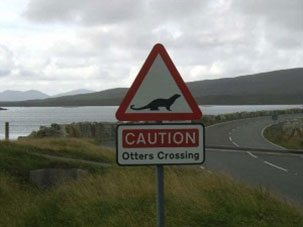
Otter Spotting
As it comes towards high tide, the otter usually heads for its holt, which is its home and rest area. It is also where they rear their young.
Barpa Langass
Barpa Langass to the south of the Island is a 5,000-year-old burial chamber thought to be the burial place of a Neolithic chieftain. Trinity Temple is a historic ruin, listed as of European significance and possibly Scotland’s oldest University. The building is the remains of a medieval monastery and college, the building has been extended up to the 16th Century but destroyed after the reformation.
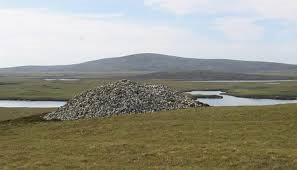
Barpa Langass
Again, restored in the 19th Century. You can park just off the main A865 road, near Temple View Guest House, Access is through the gate and about 200 metres walk from the car park.
North Uist Campsites
Balranald Hebridean Holidays is located by the beach and within the RSPB nature reserve. There is the opportunity to observe birds that have made a home amongst the machair. The campsite itself caters well for motorhome’s and offers laundry facilities, as well as toilet and shower blocks, chemical waste point and electric hook up you, will find yourself once again only a few meters from the beach.
Moorcroft Campsite on the outskirts of Cairinish is situated on a working croft and is a family run site with all the facilities you need for refreshing and emptying your tanks.
Wild camping. The map below gives an example of potential wild camp spots within North Uist.

Day 6 of Motorhome Hire Holiday
Our Outer Hebrides route will continue to take us South to south Uist. South Uist is a stunningly beautiful island of crystal-clear waters and white powder beaches to the west and heather uplands dominated by Beinn Mhor to the east.
The Kildonan Centre
The Kildonan Centre is a heritage and cultural centre which includes a museum and a craft shop. The museum itself is owned by the South Uist Historical Trust. Originally a school, it has been extended and developed into a multipurpose centre which is a Registered Museum.

Kildonan Centre
The Cladh Hallan Roundhouses
The Cladh Hallan Roundhouses are an archaeological site on the island, noted as the only place in Great Britain where prehistoric mummies have been found. In 2001, a team of archaeologists found the remains of what are believed to be two mummified Bronze Age bodies, buried under the floor of a Roundhouse at Cladh Hallan.
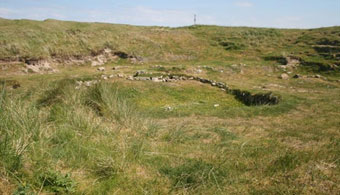
The Cladh Hallan Roundhouse
One of them was a male who had died around 1600 BC and another a female who had died around 1300 BC. At first, the researchers did not realize they were dealing with mummies as the soft tissue had decomposed and the skeletons had been buried.
Tests showed that both bodies had not been buried until about 1120 BC and that the bodies had been preserved shortly after the death in a peat bog for 6 to 18 months. The preserved bodies were then apparently retrieved from the bog and set up inside a dwelling but the reason why the bodies were mummified is a complete mystery.
Askernish Golf Club
Askernish Golf Club is home to “the most natural golf course in the world” and is a favourite stop of ours on the Outer Hebrides route. Old Tom Morris came to South Uist in 1891 to create a course at the request of the wealthy landowner - Lady Cathcart, so that she could impress her high society guests.
Old Tom created an 18-hole course that was maintained by the local crofters until the early 1920s when the demand for golf declined and meant that maintaining the course was not viable.

Askernish Golf Course
Over the next 80 years, the course was not maintained, and it went back to being wild. In 2005, a group of locals decided that they wanted to reinstate the golf course. And with the help of some of the golf industry’s biggest and best names, they set to work restoring this lost course. In 2008, the course was reopened as an 18-hole facility that has received the highest acclaim from golfing media and beyond.
Flora MacDonald Monument South Uist
After the Jacobite’s lost the battle of Culloden, Bonnie Prince Charlie fled to the Island to evade capture from the British troops. With the idea of fleeing to France, his supporters intended to smuggle him from Uist to the Isle of Skye, and then onto France by boat.

Flora MacDonald agreed to help them and on 28 June 1746, Flora, with her Irish maid Bett Burke, sailed from Benbecula over to Skye. However, the maid was actually a disguised Bonnie Prince Charlie. Unfortunately, Flora was captured by the government troops and imprisoned in Edinburgh. After her release in 1747, she returned to the Island and the plan on the map is believed to be Flora’s house.
Campsites
There are not many campsites available in the south of Uist. But remember, your sat nav is pre-programmed with places to wild camp, empty the chemical toilet, and fill up with fresh water.
Kilbride Campsite is ideal for those looking for a bit of peace and quiet. The beach is just across the road and there is a café on-site plus all the amenities you need to stock up and refill.
Gleanndal Campsite has a view across the loch and has some pitches with electric hook up, toilet/shower facilities, and chemical waste empty point.
Wild camping. The map below gives you an idea of wild campsites available.

Day 7 of Motorhome Camping in the Outer Hebrides
On the Outer Hebrides holiday tour, we suggest visiting the Isle of Eriskay which lies to the South of South Uist and is connected to the isles to the north by a causeway constructed in 2001. The name comes from the Norwegian name Èirisgeigh, meaning Eric’s Isle. The ferry to Barra sails from the southern end of Eriskay.

Eriskay ferry port
Whiskey Galore
The SS Politician was an 8000-tonne cargo ship which left Liverpool on the 3rd of February 1941 laden with amongst other things 260,000 bottles of whisky, bound for Kingston in Jamaica and New Orleans. The whisky was for the American market and therefore no duty had been paid.
On the morning of 5th February, a young man was combing a beach in South Uist when he saw the ship in trouble. After a valiant struggle by the Captain, Beaconsfield Worthington, to keep his ship on course, the SS Politician eventually ran aground in the storm onto sandbanks off the Isle of Eriskay where she began to flood.
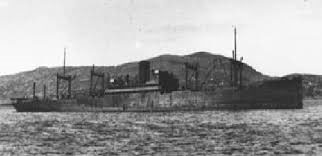
SS Politician
When the locals learned from the crew exactly what the ship was carrying, a series of illegal salvage operations took place at night before the customs and excise officials arrived. The island's supply of whisky had dried up due to war-time rationing, so the islanders helped themselves to some of the 260,000 bottles of whisky before winter weather broke up the ship. Boats came from as far and wide as news of the whisky travelled across the Whole Outer Hebrides.
The official salvage attempts were not going too well, and it was eventually decided to let the Politician remain where she was. Mr. McColl (the customs officer), who had already estimated that the islanders had stolen 240,000 bottles of whisky, ensured that there would be no more temptation. Mr. McColl applied for and was granted permission to explore the SS Politician hull.
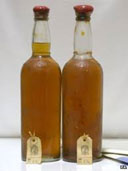
Islander Angus John Campbell, commented, “Dynamiting whisky. You wouldn’t think there’d be men in the world so crazy as that!” In 1987 Donald MacPhee, a local South Uist man, found eight bottles of whisky in the wreck. He sold them at auction for £4,000.
The wreck of the SS Politician still lies off the coast of Eriskay.
Isle of Barra
Isle of Barra is the most southerly of the inhabited islands in the Outer Hebrides. If you are travelling to Isle of Barra from Uist, take the small car ferry (okay for motorhomes) from Eriskay which will bring you to Ardmhor jetty. You can visit Calmac Ferries for ferry times.
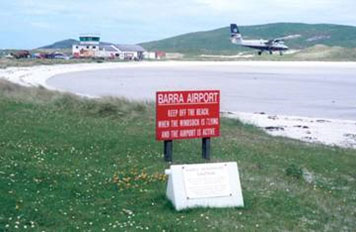
Barra Airport
Long famed for its beauty, boasting beaches, hills, machair, and moor all on a small island, Barra is a special place to visit. Their airport is one of the most unusual in the world, with flights landing on the beach at Cockle Strand in between the tides. At high tide, the runway disappears beneath the waves.
Allasdale Bronze Age Burials
In May 2007, Televisions Time Team came to the hamlet of Allasdale to investigate the exposed remains of Bronze Age burials and Iron Age roundhouses in sand dunes that had been previously uncovered by storms. The programme was broadcast on 20 January 2008.
Sea Kayaking
For an amazing sea kayaking experience, take to the water on a guided tour with Clearwater Paddling from Castlebay and explore a world of beautiful islands and sheltered bays whilst keeping your eyes peeled for the wildlife.
The Deserted Village
Balnabodach is a small township on the east side of Barra. Down by the shore of the loch are the remains of two earlier settlements, and it is here that the present archaeological studies are focused. The loch-side must have been a favoured spot for settlers for many centuries. The earliest artefact yet recovered is a barbed arrowhead of flint, dating around 2000 BC.
Excavations in 1996 found the remains left by 'Iron Age' people who lived here in the period around 200BC - AD200. The rubbish left behind by these early settlers betrayed their presence. Nearly 250 pieces of their handmade pottery were found including pieces of bowls decorated with incised patterns. There were also some flint tools including a small cutting blade and scrapers for cleaning skins.
Kisimul Castle (Seat of the clan MacNeil of Barra)
The most visible of all Barra's heritage is this restored medieval tower house castle with a curtain wall. Dictated by the shape of the low rock island on which it sits, the pentagonal castle is the first thing holidaymakers see when they come to Barra by ferry from Oban.
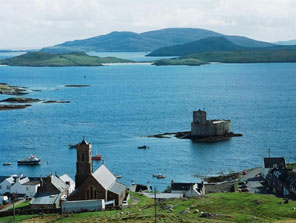
The castle would have been difficult to capture, being surrounded by the sea yet having a freshwater spring. You come to the castle by boat in a journey of 200 yards from Castlebay main street. As you approach the castle, look for a large ring of rocks to the east of the landing place: this was a catchment basin to trap fish when the tide whet out, again vital if the castle was besieged.
Like most castles, Kisimul is cold and draughty but you will enjoy clambering about. Not to be missed, in the Great Hall, is the collection of English bayonetted muskets and pikes used at the Battle of Culloden. Look out for the spartan toilets, flushed twice daily by the tide! Much of what you see is the restoration work carried out by the clan chief Robert Lister MacNeil between 1956 and 1970.
Annie Jane Ship Disaster
One of the saddest events to befall the island happened when the Annie Jane, a three-masted immigrant ship out of Liverpool bound for Canada, struck rocks off West Beach during a storm in September 1853. Within ten minutes, the ship began to founder and break up casting 450 people into the raging sea. Despite the conditions, islanders tried to rescue the passengers and crew.
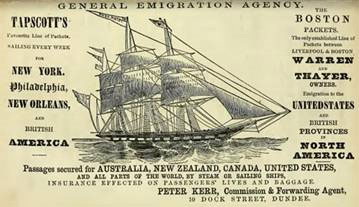
There were only a few survivors rescued. A small cairn and monument mark’s the site where the bodies recovered from the sea were buried. The inscription reads: "On 28th September 1853 the ship Annie Jane with emigrants from Liverpool to Quebec was totally wrecked in this bay and three-fourths of the crew and passengers numbering about 350 men women and children were drowned and their bodies interred here."
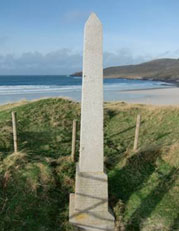
Annie Jane Ship Monument
After a busy day travelling, we recommend staying parking for one last night here in Barra on The Outer Hebrides before taking the ferry back to the mainland.
Campsites
Borve Camping and caravan site is only a few miles away from the ferry port at Castle by. This is a great overnight stop with electric hook up, laundry facilities. Why not relax and enjoy your favourite tipple as you enjoy a sunset?
Day 8 of Campervan Hire Holiday
This is the end of our Outer Hebrides motorhome tour. From here take the ferry back to the mainland from Castle to Uig on the Isle of Skye (if it's 14 nights) or if you are short of time and only had 10 nights, we recommend taking the ferry back to Oban.
From here we will pick up our Scottish west coast route again.
Isle of Skye
When you arrive in Uig you need to take the A87 heading south, then turn off on the A850 at Borve. We recommend you visit Dunvegan Castle.
If you are using a campsite tonight, we have been to and are happy to recommend the Kinloch campsite at Dunvegan which is right by the sea. Only a short walk from the campsite is the Old Schoolhouse restaurant. Here you can enjoy a huge plate of langoustines and a very nice, cooked steak if the seafood is not for you.
Dunvegan Castle
A must visit when in the Isle Of Skye is Dunvegan Castle and Gardens with a wealth of history and has been the ancestral home of clan MacLeod for over 800 years, Dunvegan is the oldest continually unhabituated castle in Scotland, which has been built the most stunning Lochside setting. The Castle has recently become a popular venue for weddings.
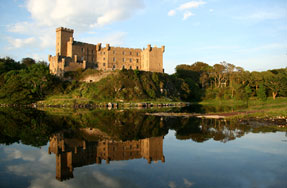
Campsite
Kinloch Campsite is on the shore of Loch Dunvegan and is a family run site with all the amenities you will need. A short walk will take you into the village where you will find local shops and cafes.
Wildcamping is available in Skye and can be found in your sat nav. Our favourite wild camp spot is at Duntulm. However, you might want to rethink your route because Duntulms is north of Uig.
So, when you get off the ferry you might want to head north and visit the Skye Museum of life which gives a history of how the Islanders lived and earned a living in bygone years.
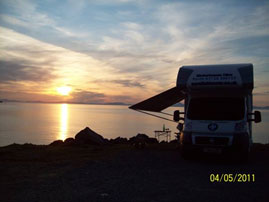
If you go past the Museum for around two miles on the left is a fantastic wild camp spot at Duntulm next to the Sea overlooking the Western Islands of The Outer Hebrides. We think an overnight stop here with a nice glass of wine and the Barbie on is fantastic. You can sit back and enjoy the most spectacular sunset overlooking the sea across to the Islands.
Day 9 of Motorhome Camping in the Outer Hebrides
On the way to Armadale to catch the ferry back to the mainland, we suggest you continue south on the west coast of Isle of Skye on the A863. There are 2 fantastic stops before you catch the ferry.
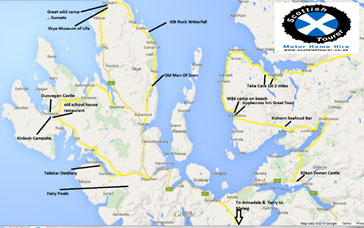
Fairy Pools
At the foot of the Black Cuillins near Glenbrittle are the Fairy Pools, beautiful crystal-clear blue pools on the River Brittle. These famous pools entice visitors from all over the world, and they make some great ‘Wild Swimming’ for those brave enough to enter the cold water. For the less adventurous, these magical Fairy Pools make some fantastic photos.
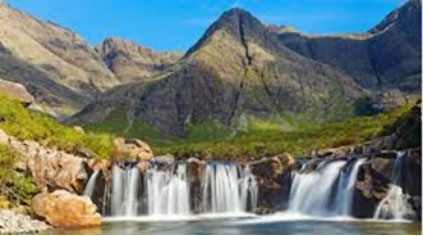
Fairy Pools Isle of Skye
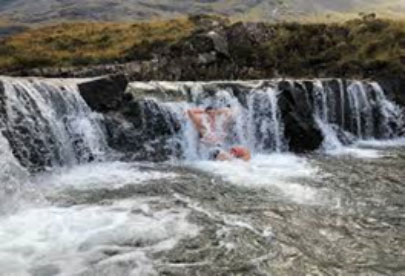
One of our customers brave enough to have a swim
Talisker distillery
Whilst on the Isle of Skye, visiting the Talisker distillery is a must. However, young children are not permitted on the tour due to health and safety. The only distillery on the Isle of Skye, set on the shores of Loch Harport with dramatic views of the Cuillins. This alluring, sweet, full-bodied single malt whisky is so easy to enjoy, and like Skye itself, so hard to leave.
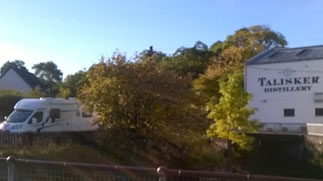
The Oyster Shed Farm Shop
At the village of Carbost near the Talisker distillery, don’t miss a visit to The Oyster Shed Farm Shop which supplies Pacific oysters grown in the crystal-clear waters of Loch Harport. If oysters are not your thing try mussels, smoked salmon, scallops, crab, and a variety of cheese and chutney, which are all beautifully arranged.
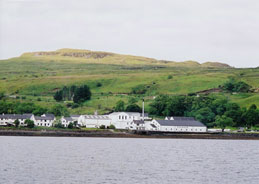
Head to Armadale A851 and take the Ferry to Mallaig on the mainland. During the summer, the Ferries run every hour or so and normally there is no need to book if the first one is full then simply wait for the next one.
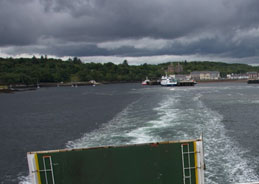
Western Isle Cruises
While in Mallaig, we would recommend you consider visiting Western Isle Cruises, who offer a one–hour wildlife cruise – where if you are lucky, you can see whales, dolphins, and a variety of sea birds.
From Mallaig head for Fort William A830.
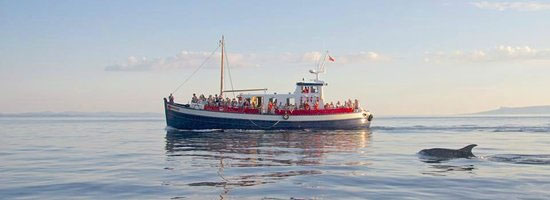
Western Isles Cruise
Campsite
If you are looking for a campsite then don’t miss the beachside campsites at Arisaig.
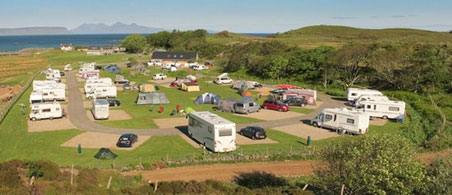
Sunnyside croft
Sunnyside Croft is one of our favourites. The owners Ian & Julie have brought camping into the 21st century. Everything is immaculately clean and modern with underfloor heating in the toilets. Each pitch has an elevated position with views over the bay.
The site is situated 200 yards from the bay where Minke whales and dolphins are frequently seen.
Day 10 of Campervan Hire Holiday
On the way to Fort William heading along the A830, stop at Glenfinnan.
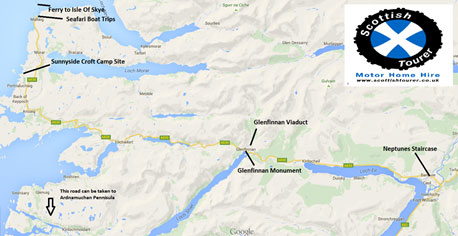
Glenfinnan Viaduct
The famous Glenfinnan viaduct has been made famous from its feature in the Harry Potter films and books. The Jacobite steam train runs across the Bridge travelling between Fort William and the seaside town of Mallaig on the west coast during the summer months.
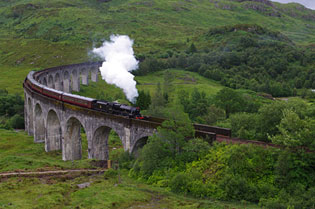
Glenfinnan Viaduct
The railway bridge spans 1,000 ft and is 100 ft above the ground level. Please bear in mind if you wish to travel on the Jacobite Steam Train it needs to be booked many months in advance to avoid disappointment.
The Jacobite Steam train
The Jacobite steam train is known as one of the world’s best train journeys. The 84-mile round trip enjoys a fantastic list of impressive views.
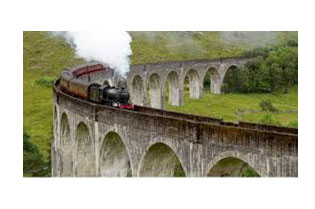
The journey starts near Fort William close to Britain’s highest mountain Ben Nevis through the most westerly Railway station in the UK – Arisaig. The train passes Britain’s deepest freshwater loch - Loch Morar. Round by Britain’s deepest seawater loch - Loch Nevis and not forgetting the amazing crossing over the Glenfinnan Viaduct.
This was made famous by J.K, Rowling in the Harry Potter films, the viaduct is also known as “The Harry Potter Bridge.”
Glenfinnan Monument
At the head of Loch Sheil stands the monument to the final Jacobite rising. The lone highlander in his kilt sits on top the 18-metre-high stone column, with stunning views of the sweeping glen below where highland life was so cruelly extinguished. The visitor centre gives full details of the Jacobite rise and fall. Be prepared to be emotionally stirred by this tumultuous chapter in Scotland’s history.
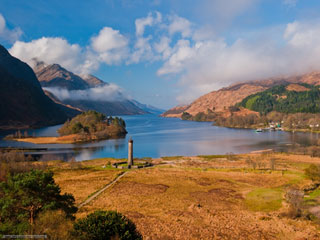
Lone Highlander at Loch Sheil
Neptune’s Staircase
Neptune's Staircase is on the Caledonian canal near Fort William, comprising of eight locks. It was built between 1803 and 1822 by Tomas Telford and the longest lock staircase in the UK.
The original system was hand-powered and has been converted to an electric hydraulic system in recent years. It lifts boats 64 feet through the eight locks which are 180 feet by 40 feet and takes about 90 minutes to pass through the system.
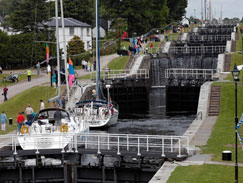
Neptune’s Staircase
Fort William makes an ideal stop overnight, known as the outdoor capital of Scotland. There will be something here for everyone, whether you enjoy walking, fishing or more adrenaline-fuelled hobbies.
Campsites
Glen Nevis campsite ,situated at the bottom of Ben Nevis, this is a lovely campsite with everything you need on-site - from restaurants, shops, kids' play area, and laundry facilities.
Wild Camping
From Fort William, take the Glen Nevis Road and follow the road past the waterfall right to the top (Not suitable for Lewis or Bara models due to height restriction). Here you can park overnight at the bottom of Ben Nevis in complete peace and tranquillity in the heart of the highest Mountains in the UK.
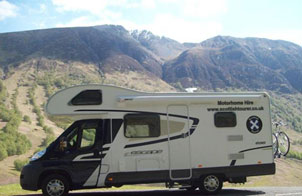
Wild camp spot near Fort William
Alternatively, you can wild camp at the Glencoe Ski Centre. From Fort William follow the coastal road A82 down towards Oban. On the way bare left into Glencoe A82 turn round at Kings house and head back towards Oban A828.
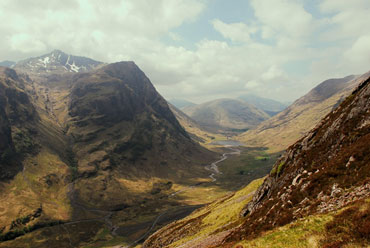
This is a stunning drive with through Scotland's highest mountain range. Overnight parking is available at Glencoe Ski Centre £12.00 per night.
Day 11 of Motorhome Camping in the Outer Hebrides
From Fort William, head towards Oban on the A82, then take the A828 and follow the road down by Loch Linnhe.
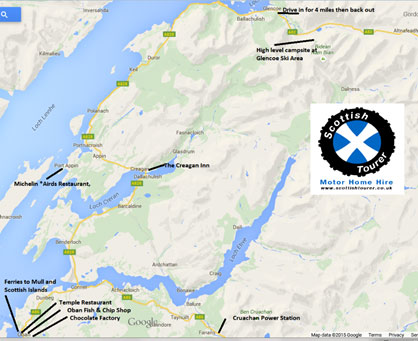
Cruachan power station
Cruachan Power Station is an amazing feat of engineering with the inside of the mountain hollowed out to house the power station. This is so the local scenery was not spoiled. The tour will take you 1 km inside the mountains, going on a short journey deep inside the mountain Ben Cruachan.
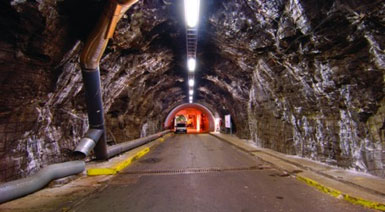
Cruachan Power Station
Once inside the mountain on the walkway, you will notice sub-tropical plants which are well suited to the humid conditions inside the mountain. In the massive generating hall, there is a viewing gallery, showing the four generators producing the electricity from the water which is stored in the loch above the mountain.
Oban
When in Oban, there are many burger style vans along the promenade. However, they are selling fresh-caught seafood, which is cooked in front of you - scallops, crab, mussels, etc, If you want to spoil yourselves then head to the Temple Restaurant, located on the seafront with magnificent views and food to match, freshly caught and all the sauces are homemade.
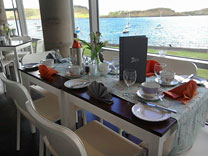
Known locally as The Green Shack, the Oban Seafood Hut is a firm favourite with locals and visitors alike and has a delicious array of lobster, scallops, crab and other seafood delicacies. It’s situated on the south side of Oban near the railway pier, where you can buy your favourites to eat on the spot or to take home with you to enjoy later.
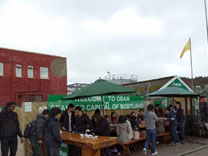
From Oban, head down the A816 towards Lochgilphead then take the A83 along the Banks of Loch Fyne towards Inveraray.
Loch Fyne Oyster Bar
Near the top of Loch Fyne is the Famous Loch Fyne Oyster bar. The oysters here are harvested in Loch Fyne itself and served up in some of the finest Michelin-star restaurants. With available dine in option, the restaurant will allow you to park overnight in the overspill car park next to the loch, making this an ideal spot to wild camp overnight.
Day 12 of Campervan Hire Holiday
From here, take the A82 through the Arrochar Alps and down the Famous Rest and Be Thankful Road towards Crianlarich. The A85 towards Lochearnhead wild camping is available at various spots along the loch. Take the A84 towards Stirling afterwards.
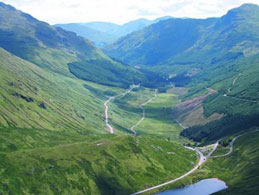
The rest and be thankful mountain pass
Inverary is on the edge of Loch Fyne and is a small quaint town with lots of history. Inverary Castle is the ancestral home of the Duke of Argyll, Chief of the Clan Campbell - the iconic must-see visitor attraction on the West Coast of Scotland.
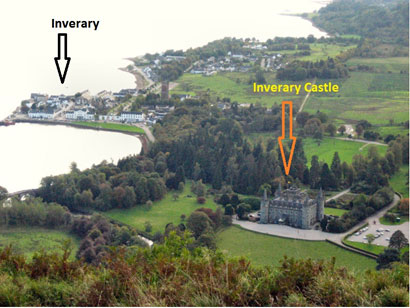
Inverary Castle
This iconic and romantic castle was built sometime in the 17th century, on the shore of loch Fyne. Inverary Castle is a good stop where you can explore the castle and gardens before stopping for a quick cup of tea in the café and browsing the gift shop.
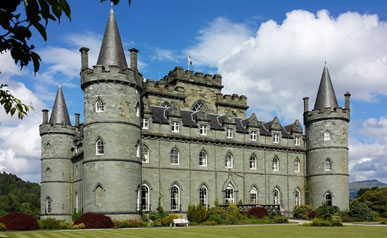
Inverary castle
From Inverary you have 2 options: if you have time to visit Stirling then head along the A85 then join the A84 for Lochearnhead heading towards Callander.
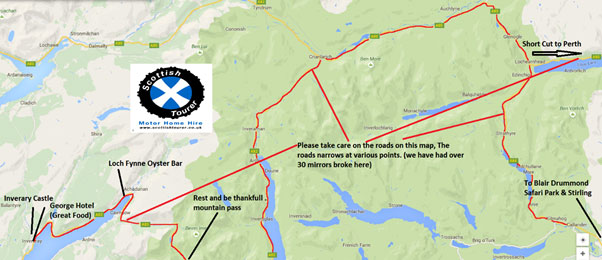
If you need to get back to Perth, continue on the A85 towards Crieff. There are campsites available in Crieff, Perth, and at Scone, all of which are within half an hour's drive from Perth. This will allow you to empty the chemical waste, garbage bins, and top up freshwater before you return to the motorhome. Don’t forget to allow time to top up the gas if you have not done so already.
On the way to Stirling, stop off at Blair Drummond Safari Park.
Blair Drummond Safari Park
Blair Drummond Safari Park is a great stop to allow the kids to run about and play. Drive the motorhome through the various enclosures and get close to lions, monkeys, tigers, elephants, giraffes, bears, etc. It is also a kids’ adventure park with water slides and sea lion/ seal shows - a great day out for kids and adults alike!
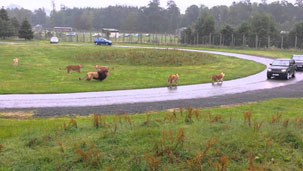
Blair Drummond Safari Park
Stirling Castle
One of Scotland’s most famous castles, Stirling Castle was home to Mary Queen of Scots. It sits high on top of the hill and dominates the Stirling skyline. This is a worthwhile visit, offering our guides and gift shop and café for any souvenirs.
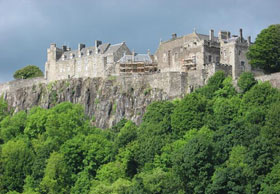
For your last night, I would recommend The Witches Craig campsite. It is close to the Wallace monument and is an ideal last night stop to clean the motorhome and empty the toilet before the 45-minute journey back to Perth.
That’s it for our Outer Hebrides route! I hope you find this route helpful in planning your holiday to the Outer Hebrides. In our opinion, some of the most breathtakingly beautiful scenery makes it a pleasure to drive.
Although we have broken it into suggested nights, the whole point of a motorhome holiday is not to be tied down to certain locations and hope when you’re out driving you can experience the freedom of the motorhome and use this as a guide.
For inquiries and questions regarding this route and our campervans for hire, contact our team and we would be happy to assist you with your needs.
Responsible wild camping in the Outer Hebrides
While we prefer not to stay in campsites, we would like to remind all our customers about the importance of responsible wild camping.
- Only take pictures and only leave footprints.
- If there is any litter, please pick it up even if it’s not yours.
- Use common sense, never park in front of someone’s house blocking their view.
- Don’t park at farmers gates or field entrances.
- Please use the local village shops rather than the big supermarkets, the product is normally sourced locally and is of much higher quality and tastes delicious.
WARNING: This route and wording are copyright by Scottish Tourer and only available for use by customers of Scottish Tourer. Any other Campervan Hire Company using any material copied from this route will result in copyright infringement and we will prosecute.
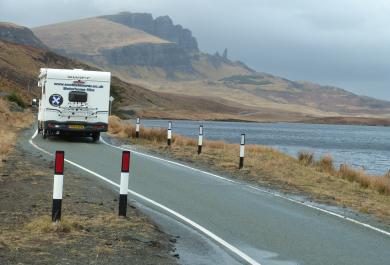
Driving Routes
Motorhome Hire Scotland - Itinerary Guide
Scotland is a very beautiful country, rich in culture and history...
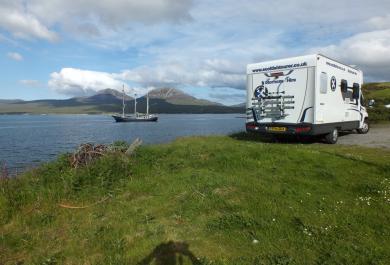
West Coast route
We are the only company who have all brand new very high specification motorhomes, however and more important than that is the service and advice of where to go and also where not to go from experienced expert local motor homers.

West Coast Route with Children.
Trying to strike a balnce of keeping the kids amused and still enjoying a holiday thats both active and intresting is not always easy, our west coast route is based on our own experiance's with some suggested stops that my children have enjoyed along the way.

 Call Us
Call Us Email Us
Email Us Add to Contacts
Add to Contacts Latest Review
Latest Review Book Now
Book Now
